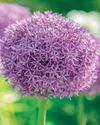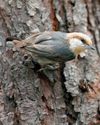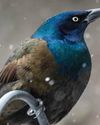
TO FEED OR NOT TO FEED
Depending on the situation, it's more appropriate to hand-feed small birds, such as this tufted titmouse.
If you feed birds long enough, you're almost certain to have a close encounter. Maybe a hummingbird zooms to the sugar-water feeder while you hang it up. . Or perhaps a chickadee perches just above your head as you bring out a fresh batch of sunflower seeds. It's only natural to wonder, Could I get these birds to eat out of my hand?
The thrill of connecting with a wild bird is undeniable. For something so small, birds are intensely alive, especially when seen up close. And, with patience, many songbirds can be enticed to take seeds from your hands, but here are some things to think about before trying.
Safety First
Consider whether it's safe for the local birds to become tame around humans. If you have a large property and peaceful neighbors, wild birds that learn to trust people may not have any problems. But in other situations, it might be risky for them to become too friendly.
Esta historia es de la edición February/March 2023 de Birds & Blooms.
Comience su prueba gratuita de Magzter GOLD de 7 días para acceder a miles de historias premium seleccionadas y a más de 9,000 revistas y periódicos.
Ya eres suscriptor ? Conectar
Esta historia es de la edición February/March 2023 de Birds & Blooms.
Comience su prueba gratuita de Magzter GOLD de 7 días para acceder a miles de historias premium seleccionadas y a más de 9,000 revistas y periódicos.
Ya eres suscriptor? Conectar

Basics of Hydroponics
Use these top tips and plant picks to have a successful soil-free garden

Rooted in Resilience
These hardy perennials will thrive in most zones

Social and Supportive
Brown-headed nuthatches take a helpful approach to raising their young

All About Owl Pellets
And why you should give a hoot about them

Ask the Experts
Advice from our pros about houseplants, bird feeding and more

BRING THE OUTDOORS IN
Making a terrarium is about as close as you can get to a Zen DIY project. Once you have gathered the proper materials and squared away your plant selections, it's as simple as layering it all together and watching your mini ecosystem thrive. Here, I'll walk you through my foolproof process and cover all the required elements for good filtration, healthy soil, strong root growth and resistance against fungus and disease.

GROW THIS. NOT THAT
Six easy-to-grow houseplants—and six that may not be the right choice for you

Winter MAGIC
Forecasts may be frigid, but grab your binoculars because birding opportunities are still incredible

Sense or Nonsense? - Why some birds can taste and smell - but others can't
Does a porcelain berry taste like a blueberry to a gray catbird? Does a block of lard smell like frying bacon to a northern flicker? The short answer is no. While some avian species do have a well-adapted sense of taste or smell, they can't distinguish between flavors and odors the way humans can. They're not picking up every ingredient in the suet you put out, says José Ramírez-Garofalo, an ornithology researcher at Rutgers University in New Jersey and the director of Freshkills Biological Station in Staten Island, New York.

Maple Mania - Amazing facts about this fall foliage mainstay
Amazing facts about this fall foliage mainstay